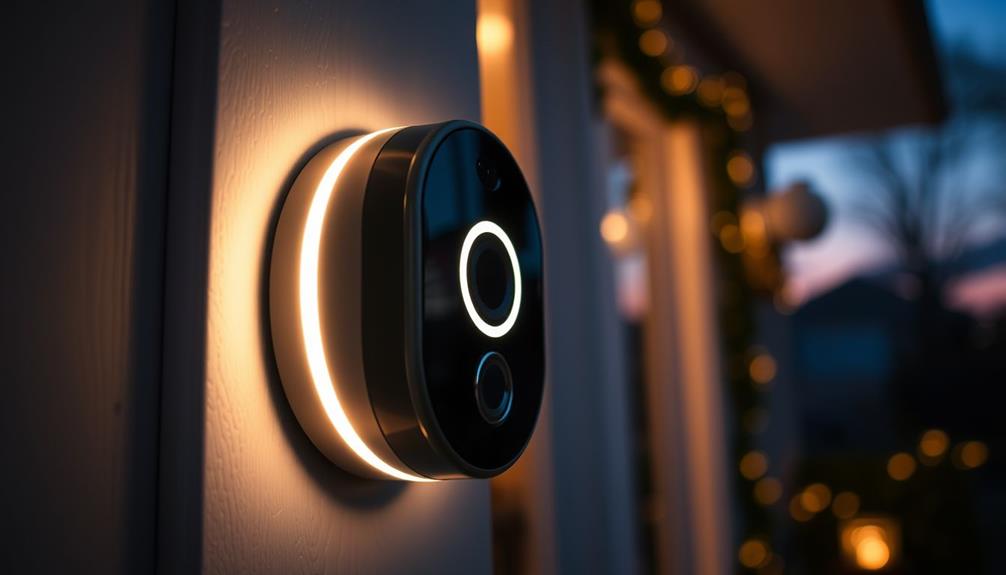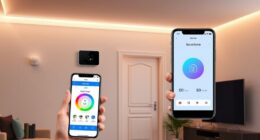To improve the weak connection on your Ring Doorbell, start by checking your Wi-Fi signal strength using the Ring app. Aim for an RSSI value below 50 for optimal performance. If it exceeds 60, consider relocating your router closer, ideally within 200 feet, and avoiding obstacles like walls and metal objects. You can also enhance router settings by switching to a less crowded channel. If issues persist, a Wi-Fi extender may help enhance your signal. This way, you can ensure smoother operation for your Ring Doorbell and enhance overall connectivity. There is more to discover about effectively enhancing your setup. If you continue to experience a poor connection after trying these steps, it may be necessary to troubleshoot any problems with the Ring Doorbell itself. One common issue is the “troubleshooting ring doorbell streaming error,” which can be caused by various factors such as outdated firmware or a malfunctioning device. In such situations, contacting Ring’s customer support for further assistance can assist in pinpointing and resolving the problem. By addressing both your Wi-Fi signal strength and potential device issues, you can guarantee that your Ring Doorbell functions smoothly and reliably.
Key Takeaways
- Relocate your Wi-Fi router within 200 feet of the Ring Doorbell to enhance signal strength and connectivity.
- Monitor the RSSI values using the Ring app; aim for values below 50 for optimal performance.
- Avoid physical obstructions and interference from devices like microwaves by positioning the router centrally and elevated.
- Use Wi-Fi extenders to boost signal strength in areas with weak connectivity, ensuring they are placed strategically.
Common Connection Issues
Poor connection on your Ring Doorbell often reveals itself through high RSSI values, with anything above 60 indicating a weak signal and potential connectivity troubles.
You'll likely experience poor WiFi connection, resulting in delayed notifications or video feeds. It's crucial to identify these connection issues to guarantee your Ring device operates smoothly.
One common culprit is the placement of your Wi-Fi router. If it's over 200 feet away or blocked by walls or furniture, the wifi signal can weaken considerably.
Try relocating your router closer to the Ring Doorbell and verify there are minimal obstructions.
Additionally, overcrowded Wi-Fi channels can interfere with your connection. If other networks are using the same channel, you may experience delays.
Switching to a less crowded channel can improve your signal strength.
For enhancing your indoor environment, consider using an air purifier to reduce allergens and improve air quality, which can indirectly support better device performance.
Causes of Poor Wi-Fi

Several factors can contribute to a weak Wi-Fi connection for your Ring Doorbell, impacting its overall performance and reliability. Understanding these causes can help you identify potential issues and improve your device's connectivity.
| Cause | Impact on Wi-Fi Signal | Solution |
|---|---|---|
| Overcrowded Wi-Fi Channels | Can lead to poor RSSI and delayed notifications | Switch to less crowded channels |
| Poor Router Placement | Affects wifi reception, weakening the signal | Place router within 200 feet of Ring |
| Interference from Devices | Disrupts signal strength, causing connection drops | Keep devices like microwaves away from router |
Obstacles like walls or metal doors can also obstruct the wifi signal, leading to increased latency. Additionally, check your network configuration; if your Ring device connects to a faulty suggested network, it may struggle with poor reception. By tackling these issues, you can enhance your Ring Doorbell's wifi performance and enjoy a more reliable connection.
Improving Router Placement

To enhance your Ring Doorbell's connectivity, it's essential to strategically place your Wi-Fi router for ideal signal strength.
Heat pumps, similar to your Ring Doorbell, rely heavily on effective communication between components, so guaranteeing your Wi-Fi is strong can be likened to maintaining heat pump efficiency.
Start by positioning your router within 200 feet of the Ring Doorbell. This distance helps guarantee a strong Wi-Fi signal, which is vital for effective communication between the devices.
Elevate your router by placing it on a shelf or mounting it high on a wall. This minimizes obstructions and boosts the signal reach.
Avoid locating the router near walls or large furniture, as these physical barriers can greatly weaken your Wi-Fi strength.
It's also important to keep the router away from major electronic devices like microwaves or cordless phones. These can interfere with your Wi-Fi signal, causing connectivity issues.
After you've adjusted the router placement, test the connection to see if there's an improvement in your Ring Doorbell's performance.
You should notice a more stable connection and fewer interruptions.
Checking Signal Strength

Checking the signal strength of your Ring Doorbell is essential for guaranteeing a reliable connection and optimal performance. You can easily check this using the Ring app. Navigate to the Device Health section, where you'll find the current Received Signal Strength Indicator (RSSI) value for your doorbell.
Here's a quick reference table for understanding RSSI values:
| RSSI Value | Signal Strength |
|---|---|
| 0 – 49 | Strong Connection |
| 50 – 67 | Moderate Connection |
| 68 – 75 | Weak Connection |
| 76+ | Poor Connection |
For ideal performance, aim for an RSSI value below 50. Values above 60 indicate a weak connection, potentially leading to issues with your Wi-Fi. If you notice an RSSI of 68 or higher, it may be time to troubleshoot or reposition your router. Monitoring your signal strength regularly can help you identify trends and make necessary adjustments to improve your connection. Keeping an eye on the RSSI values guarantees your Ring Doorbell operates effectively, providing you with reliable notifications and smooth video streaming.
Optimizing Router Settings

To boost your Ring Doorbell's connection, start by optimizing your router settings.
Ensuring that your router operates on the least congested channel can help mitigate interference from other devices.
Additionally, considering the impact of environmental factors, such as temperature variations, can enhance your network's reliability, similar to how wind energy relies on air pressure differences.
Focus on selecting the best channel and placing your router in an ideal location to minimize interference.
These adjustments can greatly enhance the performance of your device.
Channel Selection Strategies
Selecting the right Wi-Fi channel is essential for enhancing your Ring Doorbell's connectivity and performance. By implementing effective channel selection strategies, you can considerably improve the Wi-Fi signal and reduce interference, which is particularly important given the increasing number of devices connected to home networks.
As noted in recent trends regarding cybersecurity measures, ensuring a strong and reliable connection also helps protect your devices from potential vulnerabilities.
Here are some steps to help you optimize your router settings:
- Analyze Channel Congestion: Use Wi-Fi Analyzer tools to check which channels are crowded in your area. This will help you identify less congested options.
- Choose Less Common Channels: Avoid the commonly used channels (1, 6, and 11) when configuring your Wi-Fi router. Opt for channels that are less populated to improve the Wi-Fi.
- Manually Adjust Settings: While many routers automatically select channels, manually adjusting the channel settings can sometimes yield better results.
- Test and Reassess Regularly: Periodically check your router's channel performance and make adjustments as needed. This helps maintain a stable connection for your Ring Doorbell.
Router Placement Tips
Optimizing your router's placement can greatly enhance the connectivity of your Ring Doorbell, ensuring a stronger and more reliable signal.
Start by positioning your router centrally in your home and at an elevated height. This helps maximize coverage while reducing obstructions between the router and your Ring device.
Additionally, consider using a smart device that can help manage your network traffic for better performance. Aim to keep the router within 200 feet of the doorbell to maintain a strong signal and reduce latency.
Avoid placing the router near walls, metal objects, or electronic devices that could interfere with the Wi-Fi signal, as these can lead to poor signal quality.
If possible, use the 2.4GHz frequency band for your Ring Doorbell, since it provides better range and can penetrate obstacles more effectively than the 5GHz band.
After relocating your router, regularly test the connection strength to confirm improved signal quality. Ideally, you should aim for an RSSI value below 50 for best performance.
Using Wi-Fi Extenders

If you're struggling with your Ring Doorbell's connection, using a Wi-Fi extender can make a significant difference.
These devices boost your router's signal, ensuring better coverage for your doorbell, especially in those tough spots.
Additionally, a well-connected home can enhance the overall experience of modern living, creating a seamless environment for relaxation and entertainment, much like a living room transformation.
Let's go over the benefits and some tips for installation and setup to maximize your extender's potential.
Benefits of Wi-Fi Extenders
Using a Wi-Fi extender can dramatically enhance your Ring Doorbell's connection, making it more reliable and efficient even in areas with weak signals. By boosting signal strength, you can guarantee your device operates smoothly.
Here are some key benefits of using Wi-Fi extenders:
- Improved Signal Strength: Wi-Fi extenders can help achieve lower Received Signal Strength Indicator (RSSI) values, ideally under 50, for peak performance.
- Extended Coverage Area: They increase the coverage area of your home network, allowing your Ring Doorbell to stay connected even in hard-to-reach spots.
- Reduced Interference: When positioned strategically between the router and your Ring Doorbell, Wi-Fi extenders can minimize interference, leading to better responsiveness.
- Dual Functionality: Some extenders, like the Ring Chime Pro, double as a chime for alerts, enhancing both connectivity and functionality.
Installation and Setup Tips
To guarantee your Ring Doorbell gets the best connection possible, it's important to correctly install and set up your Wi-Fi extender. Start by positioning the extender centrally between your router and the Ring Doorbell. This optimizes the signal path, reducing latency and improving connectivity. Make certain the extender is connected to a strong Wi-Fi signal; a weak connection will only worsen your issues.
For a successful installation, consider the following factors:
| Factor | Importance | Tips |
|---|---|---|
| Location of Extender | Central placement enhances signal | Avoid walls and obstructions |
| Connection Strength | A strong connection at the extender is crucial | Check using the Ring app |
| Device Compatibility | Verify your extender is compatible with Ring | Refer to the manufacturer's guide |
| Regular Monitoring | Use the Ring app's Device Health for updates | Regularly check signal strength |
Once installed, regularly monitor the signal strength using the Ring app. This will help you confirm improvements and adjust the extender's position if necessary. Following these tips can greatly enhance your Ring Doorbell experience. If you continue experiencing issues, consider looking up additional resources on **how to boost Ring Doorbell signal** for more advanced troubleshooting tips. Simple actions like reducing interference from other devices or upgrading your Wi-Fi router may also significantly improve performance. Ultimately, maintaining a stable connection will ensure your doorbell functions optimally at all times. Furthermore, positioning your router closer to the doorbell or using a mesh Wi-Fi system can help achieve a better signal for Ring Doorbell. Be mindful of walls or other barriers that might obstruct the signal, and try relocating your extender for the clearest path between the doorbell and your Wi-Fi source. Taking these proactive steps will ensure consistent performance and a better overall user experience.
Understanding RSSI Values

RSSI values are vital for determining the strength of your Ring Doorbell's Wi-Fi connection. RSSI, or Received Signal Strength Indicator, measures how well your doorbell receives the Wi-Fi signal. Understanding these values can help you diagnose poor signal issues and improve your device's performance.
Here's a quick overview of RSSI values to guide you:
- Below 50: Excellent signal strength, peak performance.
- 50-60: Good connection, but keep an eye on performance.
- 60-70: Weak signal; you may experience connectivity issues.
- Above 70: Poor signal; serious performance problems likely.
To check the RSSI values, log into your Ring account and navigate to the device settings. If you notice high RSSI values, consider relocating your router closer to your Ring Doorbell, removing obstructions, or using Wi-Fi extenders.
Community Support Resources

The Ring Community offers a valuable platform for users to connect, share experiences, and find solutions to connectivity issues with their Ring devices.
By logging in or creating an account, you can participate in discussions and ask questions about your specific problems. This interactive environment fosters collective problem-solving, allowing you to benefit from the insights of fellow users who've faced similar challenges.
Within the community, you'll find a wealth of user-generated content focused on troubleshooting poor Wi-Fi connectivity and other common issues. Engaging in these discussions can help you discover effective solutions that you mightn't find elsewhere.
Plus, the Ring Help Center integrates seamlessly with community resources, providing articles and guides on various topics, including detailed troubleshooting steps for Ring devices.
Frequently Asked Questions
Why Does My Ring Doorbell Keep Saying Poor Connection?
If your Ring Doorbell keeps saying poor connection, it's likely due to a weak Wi-Fi signal.
This could happen because of physical barriers like walls or metal doors that block the signal.
It might also be too far from your router, or other devices could be interfering with the connection.
Overloaded Wi-Fi channels can add to the issue, causing delays in notifications and video feeds.
It's crucial to troubleshoot these factors.
How to Improve Signal Strength on Ring Doorbell?
Imagine standing at your door, excitedly waiting for a visitor, only to find the Ring Doorbell's signal flickering weakly.
To boost that signal strength, make sure your doorbell's within 200 feet of your Wi-Fi router.
Check the RSSI value in the app; aim for below 50.
Switch to a 2.4GHz connection for better penetration, and consider using a Wi-Fi extender like the Ring Chime Pro to enhance coverage where it matters most.
Why Does My Ring Doorbell Keep Losing Connection?
If your Ring Doorbell keeps losing connection, it's likely due to weak Wi-Fi signal strength or interference.
Consider the distance between your doorbell and the router; if it's over 200 feet or blocked by obstacles, that could be the issue.
Check for other devices causing interference and verify your Wi-Fi channel isn't overcrowded.
Will a Wifi Booster Help My Ring Doorbell?
Imagine your WiFi signal as a bridge connecting you to the world outside. If that bridge is crumbling, it's tough to reach your destination.
Yes, a WiFi booster can strengthen that connection for your Ring Doorbell. By extending your WiFi coverage, it helps build a sturdier bridge, especially if your doorbell's far from the router.
Positioning the booster wisely can make a significant difference, ensuring you stay connected to those important moments at your doorstep.
Conclusion
In the same way a tree needs strong roots to withstand the wind, your Ring Doorbell needs a solid connection to keep your home secure.
By addressing common connection issues and optimizing your Wi-Fi setup, you can guarantee your device functions smoothly.
Remember, even the best technology can falter if it's not properly supported.
Don't let a weak connection leave you vulnerable; take action today to fortify your doorbell's link to the world outside.









